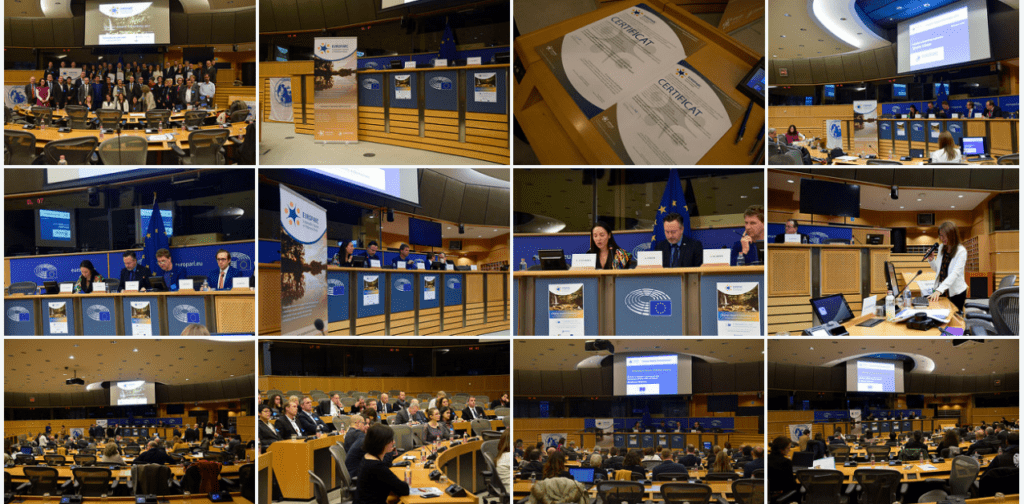Protecting old-growth forest in Europe
Montenegro, Biogradska Gora National Park © Park archive
Why discussing old-growth forest at all?
An old-growth forest is a forest that has attained great age without significant disturbance and thereby exhibits unique ecological features. In this sense, old-growth forests serve as reference for assessing the conservation status of forests and, specifically, they are used to set Favourable Reference Values for Forest Habitats identified in the Habitats Directive.
Old-growth forests are characterised by multi-layered canopies and canopy gaps, greatly varying tree heights and diameters – with diverse tree species and classes and sizes of woody debris.
This diversity of tree-related structures provide different wildlife habitats that greatly increases the biodiversity of the forested ecosystem.
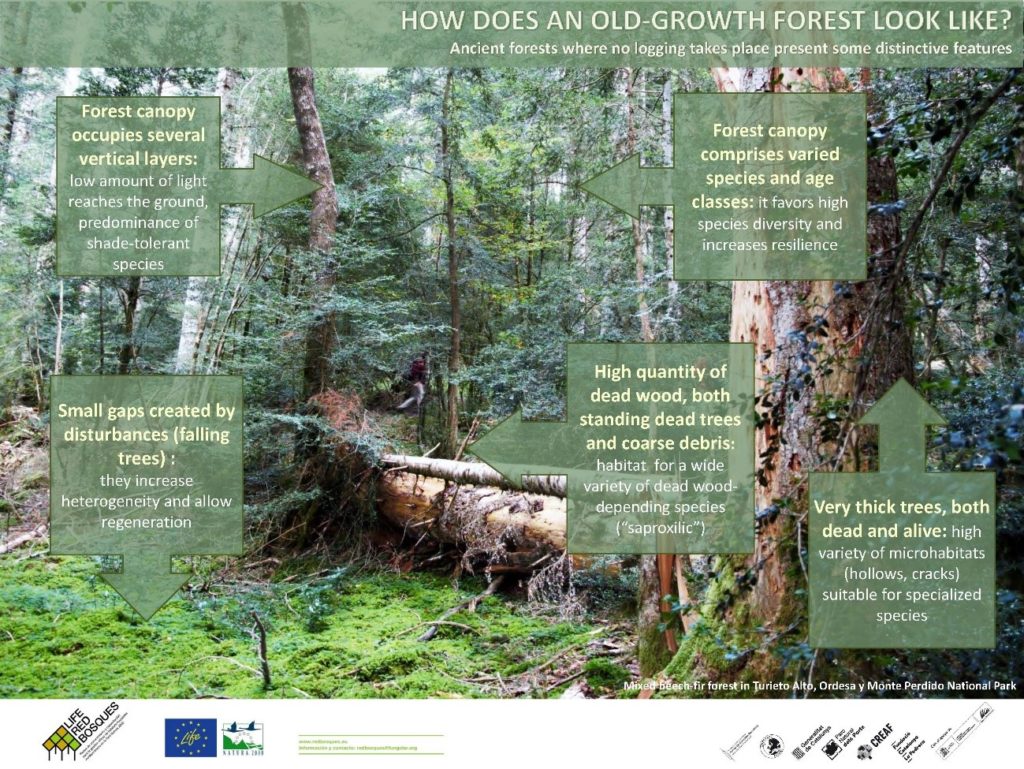
What is being discussed in Brussels…
a common protection strategy for Europe?
With the major aim to discuss options for building a common protection strategy for the remaining old-growth forest (OGF) areas across Europe, Wild Europe (WE) and the EU Committee of the Regions organised the “Conference for protection of old-growth forest in Europe” on 13th and 14th September 2017 in Brussels. Being a partner of Wild Europe, EUROPARC participated in this event, alongside with representatives from various European governmental institutions and civil society voices from local to international levels.
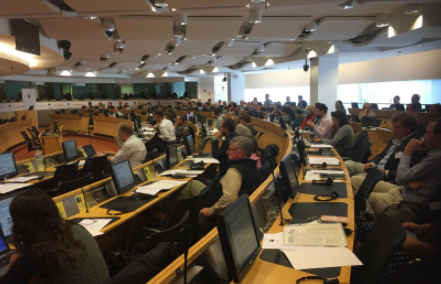
Conference for protection of old-growth forest in Europe, Brussels, September 2017 – photo by Wild Europe
Ensuring a multi-sector approach to involving the diverse stakeholders from all relevant levels was a major priority for Wild Europe when developing an effective protection strategy: At the conference, institutions such as UNESCO, European Commission, Council of Europe, national and local governments were present as well as foresters, state agencies, enterprise specialists, landowners and conservation NGOs. All contributing actively in their roles as speakers or participants towards finding a shared strategy.
The ClientEarth lawyer network was there to advise everyone on legal and policy aspects of OGF protection and the Conservation Capital provided some specialist insight how to incentivise the private sector to engage in protection activities.
Two further highlights from EUROPARC perspective:
- Our former President Erika Stanciu led a workshop on OGF management best practice & training for protection (in her role as ProParks Foundation Director and Former State Secretary for Forests at the Romanian Ministry of Environment).
- Oscar Schwendtner from Bioma Forestal introduced examples of OGF protection initiatives at local, regional, national and international level run in Spain. As example for good networking practices at national level, Mr. Schwendtner showcased the activities of EUROPARC Spain’s “Conservation Group” and introduced EUROPARC Spain’s LIFE project on OGF in the Mediterranean – “RedBosques”.
Get an idea of RedBosques further down in this article and make sure you follow their work on the project website.
Old-Growth Forests in EU Policy – is it relevant?
Posing the question, how aware EU policy-makers are of the need for OGF protection, Daniel Calleja (European Commission-DG Environment) gave an encouraging outlook,
we are committed to restoring and protecting Old Growth Forests
Humberto Delgado (Head of Natural Capital, DG Environment) supported this statement and emphasized “the value of OGF for European climate change and ecosystem services agendas”. The main topics of the consequent debate were
- whether it made sense to advocate for a specific EU policy on OGF
- whether it might be more feasible to include it in the established EU 2020 Biodiversity Strategy
- the identification of potentials how to reinforce OGF issues within the framework of Natura 2000 related policies and the Action Plan for Nature, People and the Economy.
Old-growth and future-ready: What’s needed now?
The next steps towards a common OGF protection strategy.
Main objectives and actions were mapped out at the conference and followed up by a Wild Europe Meeting in December
- The strategic objectives should be linked to the climate change agenda and indicate the economic value of OGF protection. To raise the topic on political agendas and get the private sector on board.
- Agreeing on a shared European definition of OGF. To achieve an effective common approach towards protection and restoration.
- The definition should be practical and therefore relatively flexible to allow its adjustment to different national realities and ensure it can be implemented.
- Putting in place an instrument to locate and monitor old growth forest sites across Europe. To provide early notice of prospective threats, allowing also to discriminate between “legal” and “illegal” logging activities for example.
- Conduction of an assessment of new forms of long-term protection structures: traditional and innovative, including proposals for improving cash flow opportunities from the Payment for Ecosystem Services (PES) agenda.
- Investigation of the potential of coordination between UNESCO World Heritage and Natura 2000 networks, with the protection strategy acting as a pilot.
A comprehensive compilation of the speakers, topics and presentations from the Wild Europe conference can be accessed here. You might also want to find out some further information on the preparatory consultations for the proposed protection strategy, but most importantly: Make sure you follow the updates on the process provided here or by getting in touch with Wild Europe.
Different countries, different relevance
What’s being done across countries already?
The high number of registrations to the conference (about 150 participants from 28 EU and non-EU countries) indicates the high interest in the issue by the different countries. From Wild Europe Network, members confirm that the identification of new OGF areas and their protection was currently high on Romanian and Ukrainian political agendas (including allocation of funding). In Austria, the topic was not discussed as extensively but was nevertheless considered relevant; and in the case of Germany, OGF were considered an important argument to advocate for more national wilderness.
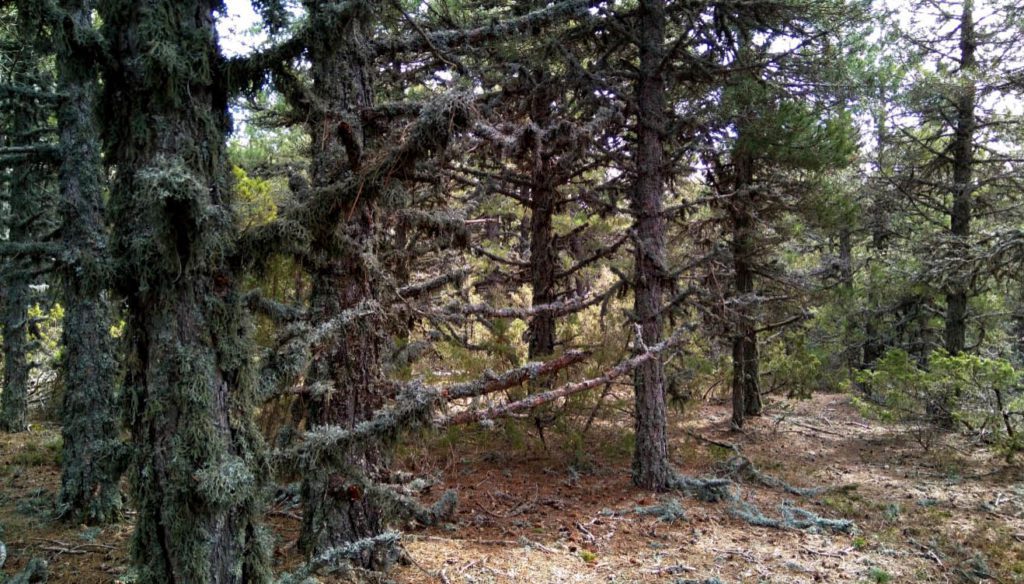
PN Puebla de San Miguel Spain
Country Case: Management of old-growth forests in Spain
What are the challenges at management level in Spain?
EUROPARC Spain old-growth forests are one of the central focus of RedBosques, a 3 year Life project, coordinated by EUROPARC Spain, which seeks to:
- outline baseline scenarios for assessing the conservation status of Mediterranean forests
- develop criteria and tools for the design and implementation of forestry management practices in Natura 2000 Mediterranean forests with objectives that regard biodiversity conservation and climate change adaptation
- transfer state-of- the-art knowledge to target audience and stakeholders.
In the context of the Life RedBosques project, EUROPARC Spain recently organised a three-day meeting (22-24 November 2017) in the Els Ports nature park (Tarragona), with about 40 attendees involving forest and protected areas managers, administration representatives and the private sector (landowners). Teresa Pastor, from EUROPARC Directorate, also attended.
The focus of the meeting was twofold: to share the progress of identification of old-growth forests in the different Spanish regions and to exchange on management practices to accelerate the process of maturation of those forests in a state close to old-growth.
Managment actions – if any – should:
- be directed to emulate nature
- by recreating natural events such as lightings and strong winds
- which would produce the fall down of tres and the breaking of branches
- eventually leaving wood debris on the soil.
Get some background on the RedBosques project beginnings in our article here. Follow how RedBosques project approaches its challenging objectives via EUROPARC Spain’s Twitter, Facebook and the LIFE project website – and make sure you don’t forget to share their outputs!
The project is coordinated by EUROPARC Spain (José Antonio Atauri) and Fundación Fernando González Bernáldez.
Advocating for the future of the EU LIFE Programme
The EU multi-annual financial framework (MFF) is being reviewed by the European Union for the programming period post-2020. Discussions have started, and EUROPARC, together with several NGOs, wants to ensure that adequate funding for nature conservation is kept.
The LIFE Programme is the main direct instrument that helps implementation on the ground, and over the past 25 years, has been a great support for the protection of Europe’s species and habitats. Recently, the European Commission’s mid‐term evaluation of the LIFE programme confirmed the LIFE programme is delivering in line with set targets.
There is evidence of a positive cost‐benefit ratio when comparing funding to societal gains and LIFE appears to cost less to manage than the other EU funded programmes. It is estimated that projects funded in the 2014 call for proposals will produce a benefit to society of approximately €1.7 billion, more than four times the overall LIFE budget for 2014.
European Protected Areas have widely trusted in the LIFE Programme to implement their conservation activities. LIFE is also a crucial instrument that can contribute to implementing the EU Action Plan for nature, people and the economy, that has been recently published by the European Commission. Therefore,
EUROPARC believes the EU LIFE programme should continue and be strengthened with a focus on supporting better implementation of the nature directives.
To raise EUROPARC’s position and stress the importance of the LIFE Programme, over the last months EUROPARC team in Brussels, President Ignace Schops and Executive Director Carol Ritchie, have organised several meetings with Members of the European Parliament (MEP).
Moreover, EUROPARC and 16 organisations members of the European Habitats Forum sharing the same position regarding the programme, have sent today a joint letter to the European Commission reinforcing the importance of the EU LIFE Programme. The full letter can be downloaded here and below we share with you the main highlights.
The EU LIFE Programme in the next Multi‐annual Financial Framework (MFF)
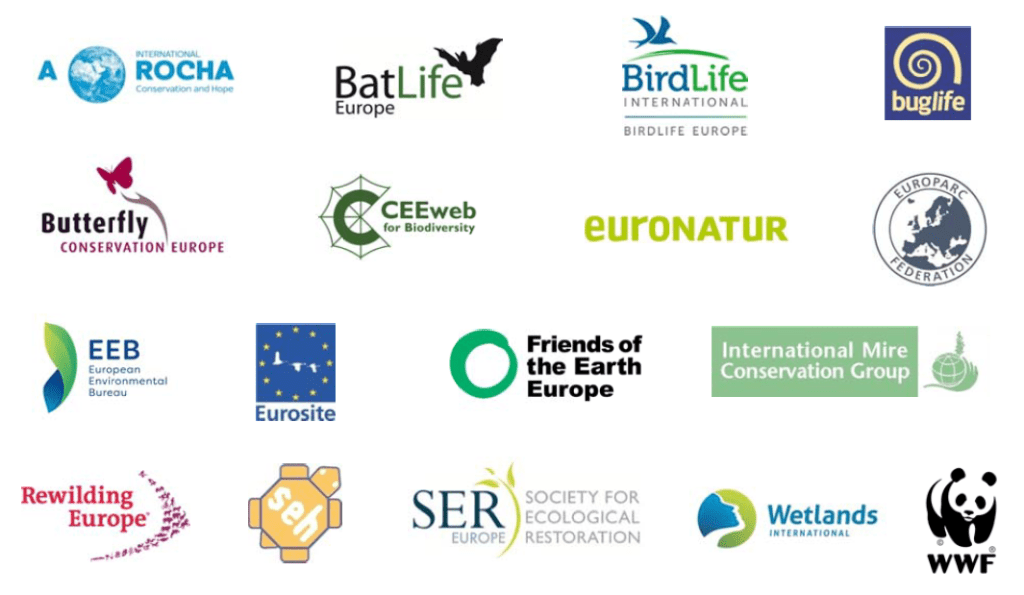
The above mentioned members of the European Habitats Forum (EHF) have agreed the following position regarding the EU LIFE Programme:
LIFE in the future EU budget:
The LIFE programme should continue in the next MFF as a standalone funding instrument. The European Commission should acknowledge the value for money of the LIFE programme, the high return rates and potential for job creation from green investments and propose a significant increase in the LIFE budget.
- Funding for LIFE should receive at least 1% of the total EU budget (currently receives only 0,3%)
- At least 50% of the LIFE budget should be dedicated to the LIFE Nature and Biodiversity sub‐programme
- The general co‐financing rate should be increased to 75% to overcome financial constraints of applicants
- The administrative burden should be reduced and a two‐step application procedure introduced
Why LIFE is important:
- LIFE promotes the EU and European integration
- LIFE promotes the values of the EU
- LIFE saves species from extinction
- LIFE is value for money – The LIFE funds bring jobs and growth. A study estimated that over its seven year duration the LIFE Programme creates 74 500 jobs (FTE), an economic growth of 9,3 billion EUR and the value of the results achieved through Nature projects alone is estimated to be 43 billion EUR.
- LIFE has lasting results
- LIFE brings people together
- LIFE innovates
Download the full letter sent to the European Commission – LIFE Position
LIFE is the only financial instrument under the EU budget wholly dedicated to the environment, nature conservation and climate change. The fund is very small: only 0,3% of the EU budget, with LIFE Nature and Biodiversity Action Grants allocated around 40% of the LIFE budget.
Updates on Omnibus Regulation & CAP reform – Council Ministers’ perspective on the “Future of Food and Farming” Communication
© Ralf Kunze on Pixabay
This week, December 11th and 12th, Ministers of the Agriculture and Fisheries Council gathered in Brussels to discuss, amongst others, the Communication on the reform of the Common Agricultural Policy (CAP) – “The Future of Food and Farming” – which the European Commission had adopted on 29th November 2017.
Does the Communication on the CAP reform cover all key issues and challenges for the post-2020 CAP? Which are the central strategic issues for the future of CAP?
These were some of the questions addressed to the Council Ministers by Jyrki Katainen European Commission Vice-President for Jobs, Growth, Investment and Competitiveness, when presenting the document.
In the press conference following the meeting, Minister of Rural Affairs of the Republic of Estonia Tarmo Tamm spoke on behalf of the Council, generally appraising the proposed ideas set out in the CAP Communication: Ministers found the current CAP had already achieved its basic objectives and hence stressed that sufficiently large portion of EU budget should be allocated also to the CAP post-2020. Accordingly,
Ministers were in favour of the Commission’s suggestion to keep the main CAP structure as it is, based on two pillars, and reinforced the position that Direct Payments to farmers were further required, while moving to a result-based approach was much favoured.
- The Ministers opposed the idea of opening Pillar 1 (Direct Payments) to a co-financing through Member States, to allow equal opportunities between countries.
- The 2nd Pillar (Rural Development measures) was considered to play a key role in solving most agricultural problems.
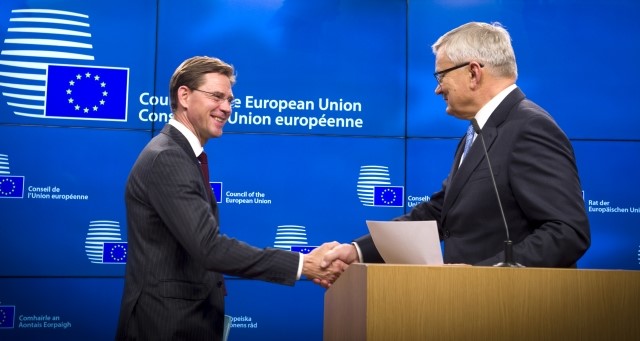
From left to right: Mr Jyrki KATAINEN, Vice President of the European Commission; Mr Tarmo TAMM, Estonian Minister of Rural Affairs,11.12.2017, Brussels © European Commission
A new “delivery model”?
While agreeing to keep a two-pillar-framework, Ministers also welcomed some new aspects introduced by the Communication. Namely a stronger emphasis on environment and conservation issues as well as a new “delivery model” – an attempt to acknowledge that the previous, rather prescriptive one-size-fits-all approach, could not sustain:
The Communication calls for an increased subsidiarity, meaning that the policy objectives agreed on at EU level will be translated into concrete national or regional strategic plans by the Member States.
Even though aimed at cutting down bureaucracy for Member States and at ensuring fit measures, this delivery mechanism is strongly criticised by member states, civil society and NGOs as it moves towards a renationalization, creating a market situation where farmers will have unequal competition conditions. Commissioner Katainen disagrees, assuring it wouldn’t happen as environmental and climate objectives in the CAP are set at EU level and Member States would have to propose their respective strategy drafts to the Commission – who will only approve them if they ensure the maintenance of a common approach to the delivery of environment and climate objectives across the Member States.
Further, while in favour of a “new delivery model”, Ministers call on the Commission to consider environmental, climate and biodiversity conservation objectives when reviewing agri-environmental measures, Greening measures (which the Commissions would like to see scrapped) and Cross-Compliance.
Council Ministers’ recommendations
Some flaws named by Council Ministers were the remaining need to introduce a real simplification and to develop effective risk management and market measures within the Communication.
Ministers found more funds of budget must be dedicated to research, development & innovation in agriculture, food and drink production as well as in rural development.
Thus arguing in line with the Commissions drive to look at opportunities from the perspectives of bio-economy and Circular Economy. Further, the Council wants to see support of a digitization of agriculture and a strengthening of farmers’ position in the supply chain as well as an increase in sustainability and attractiveness of the sector to ensure generational renewal.
Finally, Commissioner Katainen remarked, that at this point in time, the Communication does not yet provide much detail or legal substance and did not want to pre-judge outcome of Multiannual Financial Framework (MFF) negotiations. The intention was to set up a well-functioning structure, also allowing for discussion within the Council.
The meeting on the CAP Communication was not about delivering conclusions, but about reacting with questions from the Council to the Commission. Member States had the opportunity to ask for clarification, to discuss what certain points raised in the CAP Communication would mean for the implementation at national levels.
Legally relevant conclusions on the post-2020 CAP will not be made before May 2018, when the European Commission is ought to come up with their legal proposal.
Omnibus regulation – Council adopts new agricultural rules
Even if not on the post-2020 CAP Communication, there were other agriculture-related legal decisions taken within the meeting session on December 12th .The Council adopted new agricultural rules as part of the so called “Omnibus regulation”.
From the 1st of January 2018 a series of technical changes to the Common Agricultural Policy (CAP) will enter into force and affect the four current CAP regulations.
Affected are direct payments, rural development, common market organisation and the horizontal regulation:
Direct payments
- The rules on permanent grassland have been modified to provide greater flexibility for member states.
- Certain elements of greening were altered and in addition, the distinction between active and non-active farmers will become optional for Member States.
Rural development
- For risk management measures some thresholds have been lowered and support rates increased.
- Changes in the use of financial instruments were adopted.
Common market organisation
- Activities usually carried out by producer organisations (planning production, optimising production costs, placing on the market and negotiating contracts for the supply of agricultural products on behalf of members) will be extended to all sectors with a view to improving the position of farmers in the supply chain.
You can find the full text of the Regulation by the European Parliament and the Council here.
Charter Award Ceremony 2017: 21 areas awarded in Brussels
On the 7th December 2017, EUROPARC welcomed 21 exceptional Protected Areas to the European Parliament in Brussels for awarding them the European Charter for Sustainable Tourism.
The event was kindly hosted by Scottish MEP Alyn Smith from the Group of the Greens/European Free Alliance, who opened the Ceremony with a motivating message. Besides, EUROPARC was delighted to welcome a range of high-level speakers to this year’s Ceremony: Co-Chair of the Intergroup “European Tourism Development, Cultural Heritage, Ways of St. James and other European Cultural Routes” Claudia Tapardel, Vice President of the Committee of Regions Bureau, Roby Biwer and Member of Cabinet of Commissioner Vella for Environment, Maritime Affairs and Fisheries, Andrew Bianco.
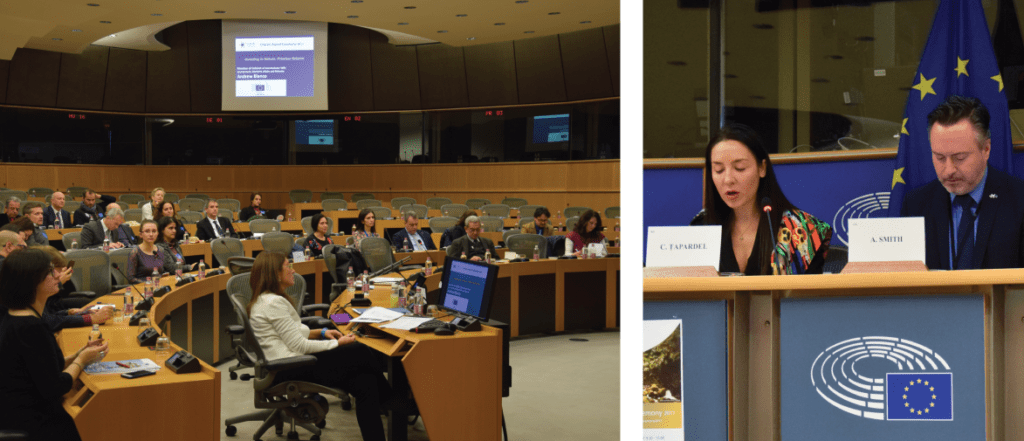
Charter Award Ceremony 2017, European Parliament © Steffi Burger
With each speaker looking at sustainable tourism from their political angle it became evident that the work of the Charter Parks is not only valued but increasingly recognized as a priceless contribution in achieving overarching European Union objectives of increased environmental, social and economic sustainability.
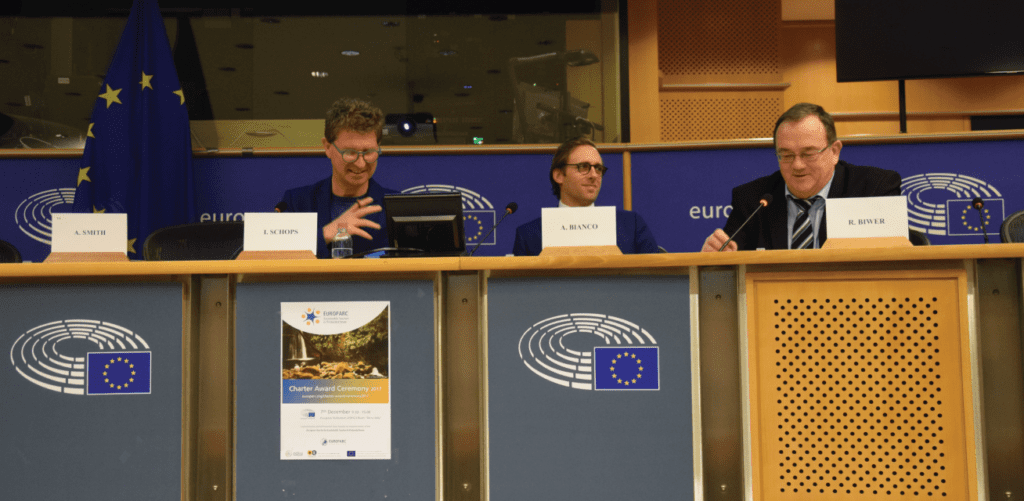
Charter Award Ceremony 2017, European Parliament © Steffi Burger
A shared vision across Europe
The European Charter for Sustainable Tourism in Protected Areas is a practical management tool that enables Protected Areas to develop and implement sustainable tourism strategies, thus benefitting nature and people as well as local economies.
This year EUROPARC re-awarded 14 and welcomed 7 new Charter Parks to the Network. With Kullaberg Nature Reserve from Sweden joining the Charter Network Family we are now counting 164 Charter Parks in 20 countries. They are spread all over Europe, but unite around the shared vision to make sustainable tourism a meaningful quality experience which safeguards natural and cultural values, supports local livelihoods and quality of life and which is after all economically viable.
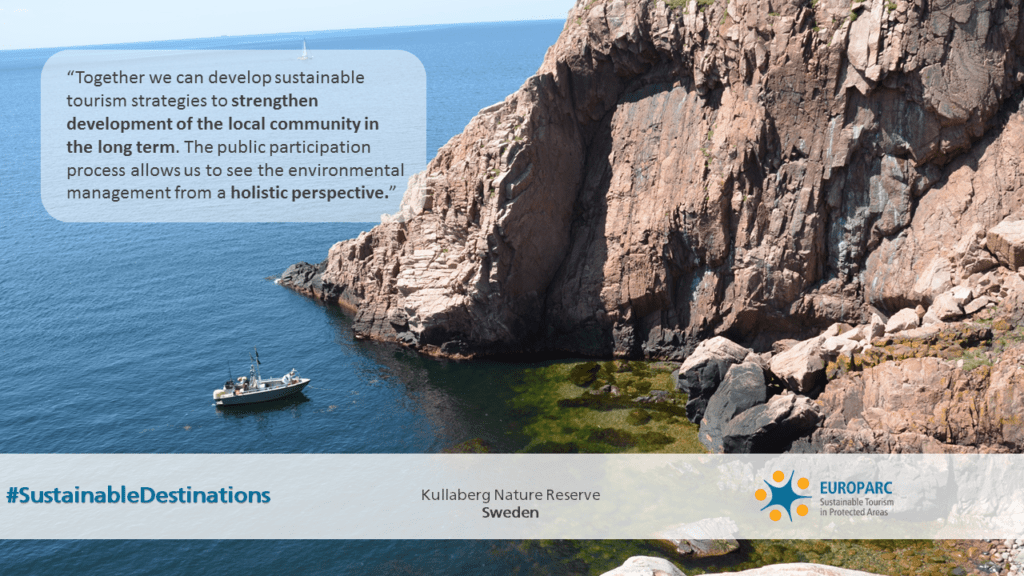
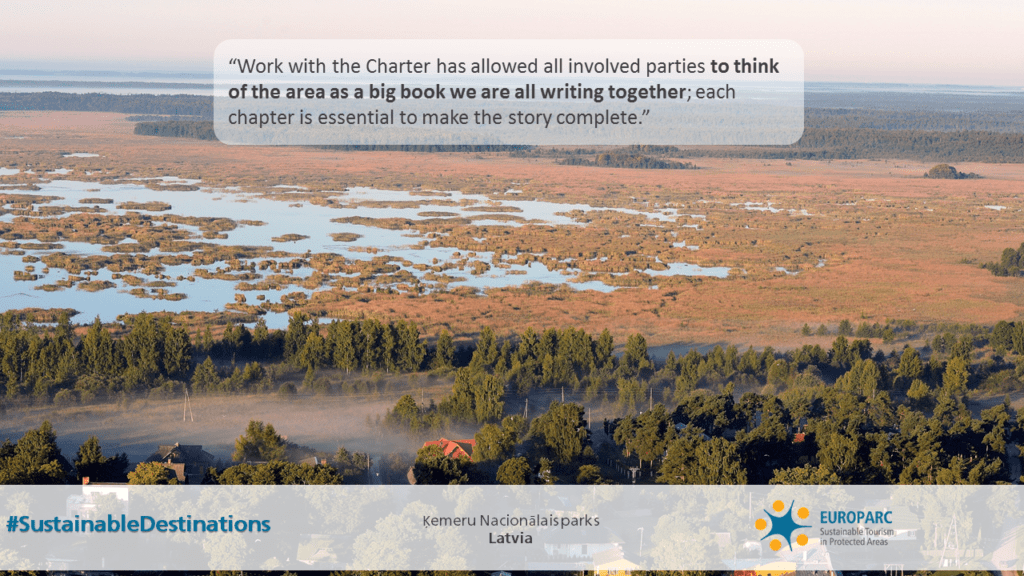
Working together
The Charter Award Ceremony has been an excellent occasion to not only celebrate 21 outstanding examples for Sustainable Tourism in Protected Areas from countries as diverse as Italy, Latvia, Spain, Finland, France, Sweden, United Kingdom and Portugal, but also allowed to share experiences and discover how every Park shares the same passion for their Nature and People, for the natural and cultural treasures.
This shared understanding could be felt in the short thank you speeches given by the Park representatives when accepting the Charter Award Certificate. Even if not all of them were given in English, combined translation efforts allowed to make every contribution understood. A beautiful example of the major aspect the Charter Network is all about. The Charter works, because we work in partnership, highlighted EUROPARC Director Carol Ritchie.
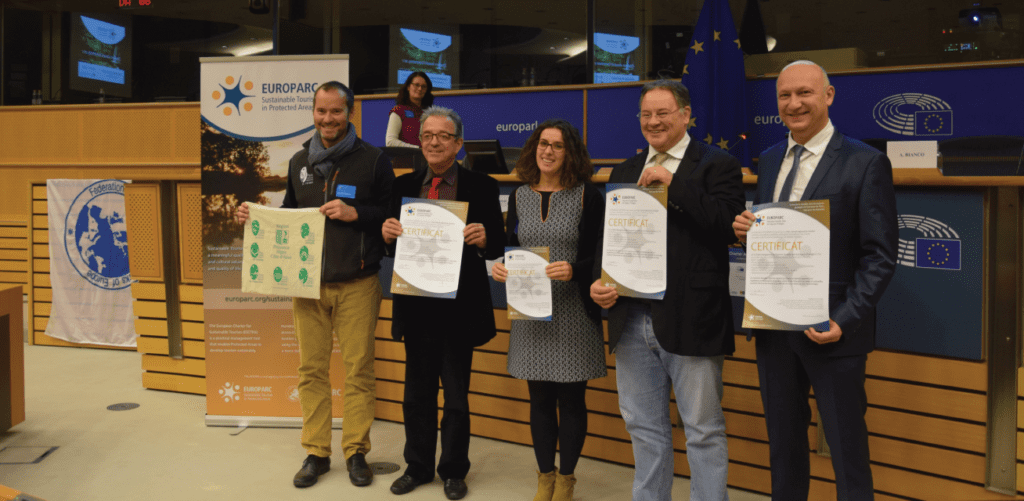
Charter Award Ceremony 2017, European Parliament © Steffi Burger
The key principles of the Charter for Sustainable Tourism in Protected Areas comprise the protection of the natural and cultural heritage, participation by all stakeholders, effective partnership working, planning to prepare and implement a sustainable tourism strategy, to realise the environmental, social and economic benefits of everyone working more sustainably.
…for natural and cultural heritage
That the Charter Network “works” could also be witnessed by the contributions of the invited speakers: Claudia Tapardel, Roby Biwer and Andrew Bianco all clearly called on the present Charter Parks – in representation for the wider Network – to seek close exchange and cooperation with their Institutions at EU level. Especially given the upcoming “European Year of Cultural Heritage”, which will be dedicated to celebrating and discovering the diverse European cultures. With our shared nature forming an inseparable part of Europe’s cultural heritage.
The upcoming year will be a chance to challenge the misconception of a nature-culture divide and to re-connect people with their natural environment.
For this reason, EUROPARC will dedicate a range of next year’s events to reinforce the authentic experience of nature-people connection, and Charter Parks can play a key role allowing people first-hand visitor experiences in their Protected Areas. The first event will be the 2018 Siggen Seminar in March, where we look at natural heritage interpretation as part of our cultural heritage. Participation is free to EUROPARC members and registrations have just opened.
We need to tap the potential of opening “hidden treasures”, as EUROPARC President Ignace Schops referred to often overlooked and undervalued “forgotten destinations”, to the immediate experience of people.
The statements shared by the Awarded Parks left no room for doubt that they are speaking the same language as the EUROPARC President. It made us understand how Protected Areas are eager and capable of bridging gaps: between nature and people or between the seemingly contradicting objectives of local economic development and nature conservation.
Sustainable Destinations awarded in 2017
New 7 Sustainable Destinations
From the 21 Charter areas that were awarded, 7 have just started their path towards becoming a Sustainable Destination.
Italy
- AMP Penisola del Sinis – Isola di Mal di Ventre
- Parco Nazional del Gargano
- Parco Nazionale del Gran Sasso e Monti della Laga
- Parco Nazionale dell`Aspromonte
- Reti di Riserve del Trentino
Spain
Sweden
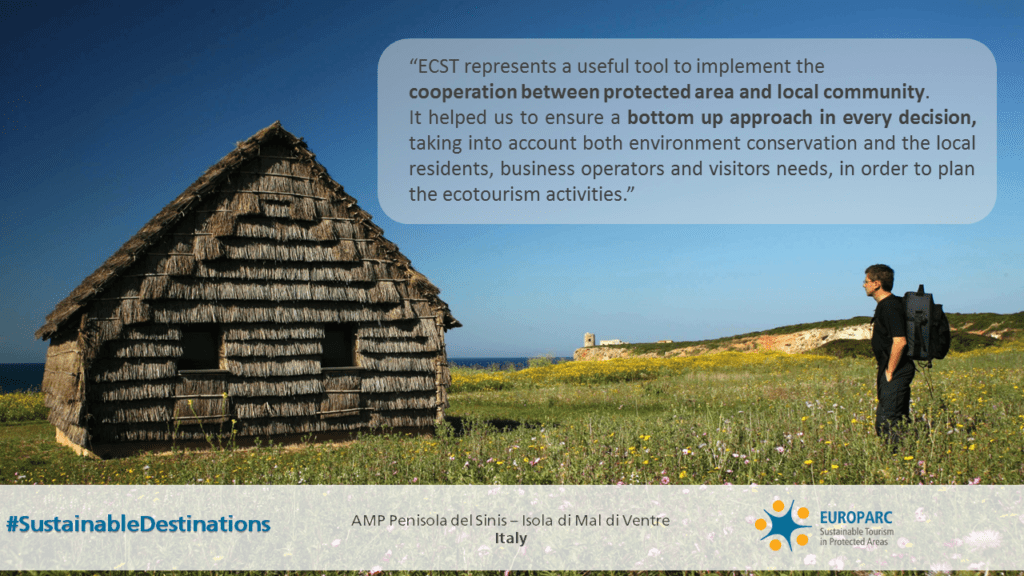
14 Sustainable Destinations re-awarded
For the first time in the history of EUROPARC, the number of Parks re-awarded was higher than the Sustainable Destinations joining the Network. This number highly reflects the commitment of Parks in working with their local stakeholders, under the standards of the ECSTPA. Several of these Parks are also implementing Charter Part II and Charter Part III, necessary steps for those willing to achieve a higher quality tourism experience, for people and nature alike.
Finland
France
- Parc naturel régional du Verdon
- Parc naturel régional de Camargue
- Parc national des Cévennes
- Parc naturel régional du Haut-Languedoc
- Parc naturel régional du Queyras
- Parc naturel régional du Vexin français
France and Italy
Italy
Latvia
Portugal
- Terras do Priolo – Life Project and Environmental Center
Catalonia
Spain
United Kingdom
We would like to congratulate and thank all the awarded Charter Parks once more for having celebrated with us here in Brussels and for having made the Charter Award Ceremony 2017 a real success!
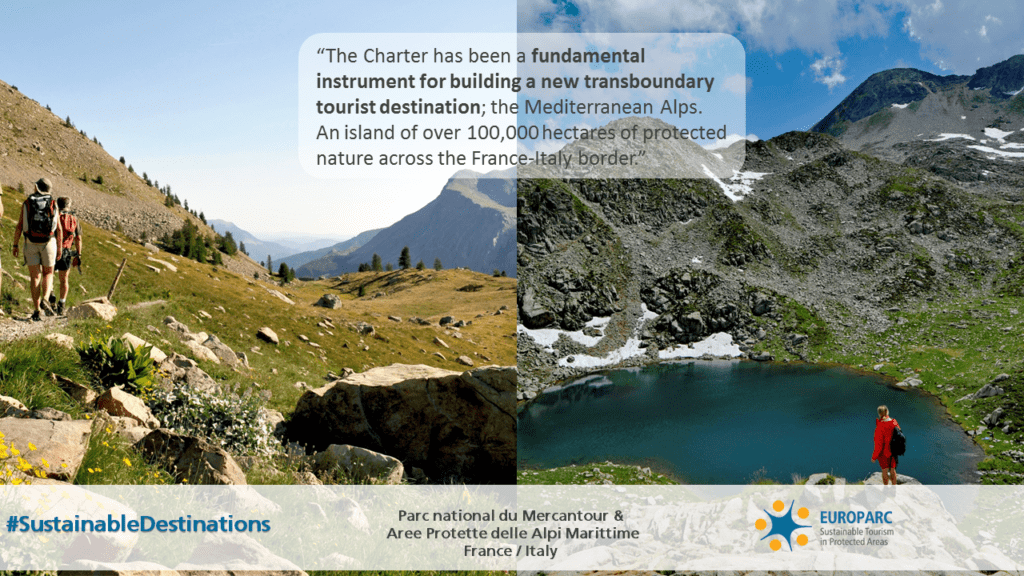
We hope the event left all participants feeling energized and inspired to engage even more with or within the Charter Network. To keep your memories alive we share with you the photos taken throughout the event.
